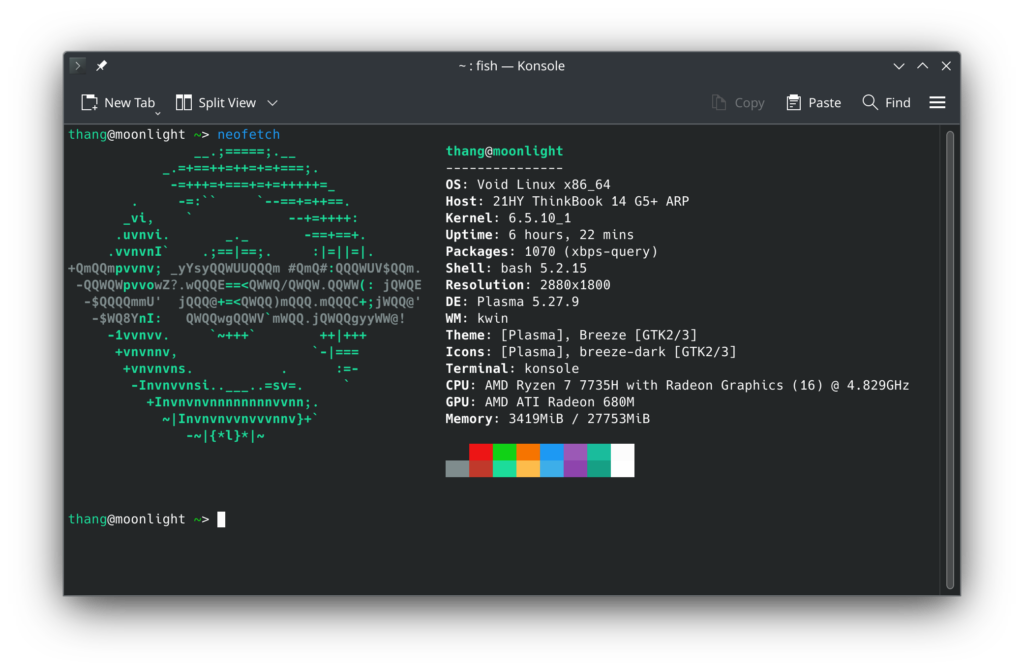Warning: Following section was written by ChatGPT. Not quite, I wrote a detailed post but not confident with my writing, so I ask ChatGPT to rewrite it. Admittedly, It’s more poetic than it should, it’s a joy to read. If you’re not fine with reading Ai-generated content, then please skip this post.
Let’s face it, fellow Linux aficionados—distro-hopping is practically a rite of passage in our world. We’ve all danced with the idea of trying out a new distribution more times than we’d like to admit. Reflecting on my Linux journey, I can’t help but acknowledge the joy it brings, but I’ve also come to realize the precious time lost in the endless cycles of tinkering and hopping between distros.
Recently, my Arch installation started feeling a bit stale, and the siren call of Void Linux became increasingly irresistible. Armed with a USB drive, I imprinted the Void image and initiated the installation process. To my surprise, the installation proved to be refreshingly simple and straightforward.
Post-installation, a deep dive into the Void wiki led me to outfit my system with KDE, dbus, and a handful of other essentials. While I successfully configured SDDM to start on boot after a few attempts, diving into KDE presented a challenge—I was greeted by a black screen and a lone mouse pointer. Following further instructions from the wiki, I installed dbus and additional packages to resolve the issue. Unexpectedly, audio refused to cooperate out of the box. Despite diligently following the wiki, frustration set in after forty minutes of troubleshooting. Late into the night and unprepared for the battle, I reluctantly abandoned Void Linux and opted for a fresh OpenSUSE Leap installation.
Fate had other plans for me. The OpenSUSE installation was underway, but a downed CDN dashed my hopes as essential packages couldn’t be downloaded, leaving me with a broken install. Frustration peaked with an exasperated “Aarghhh!” Not keen on returning to Arch, I pivoted to a clean Fedora install and called it a night. Despite Fedora’s slow package manager, everything worked seamlessly right off the bat.
But, as the Linux cycle goes, boredom struck again. This time, I sought a more cohesive aesthetic and, dissatisfied with the mismatched appearance of QT and GTK apps, I embraced Gnome. Admiring the Adwaita theme, I reveled in the new look. Yet, a few days later, a lingering preference for KDE resurfaced, prompting me to switch back. This flip-flopping, however, left behind a trail of unwanted Gnome remnants—a clutter of apps I couldn’t bear. Dissatisfied, I found myself at the crossroads, contemplating a second attempt at embracing the enigmatic allure of Void Linux.
2nd attempt at Void Linux

This time, thanks to this guide and a more thorough read, I’ve successfully set up the base system with KDE and audio working. However, although I’ve chosen the correct timezone, the time wasn’t displaying correctly. Having read about this before, I guessed dual-booting with Windows (I had to attend a class where we learned the Office suite, so you know …) was the problem. Deleting the Windows installation wasn’t the solution. I can’t remember what I did after that, but it’s working correctly now.
That’s it. I installed some software I needed and told myself not to touch anything again.
If it works, don’t touch it.
A wise programmer once said
What’s next?
As the title say, I’ve been neglecting at school. By tinkering less, I hope I have more time for my study. By the way, If you know, I really need your help on the right path to learn algorithms and data structure from ground up.
Thanks for reading!

Leave a Reply